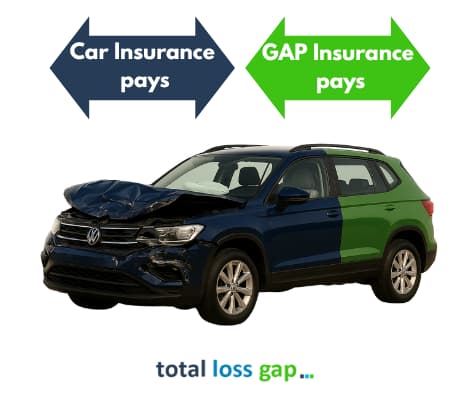Call Monday-Friday 9am - 6pm Closed Saturday & Sunday



[ Contact Us ]
Need Help? Calling from a mobile please call 0151 647 7556
0800 195 4926Do you have a question? or need help?
Call Monday-Friday 9am - 6pm Closed Saturday & Sunday,
GAP Insurance (Guaranteed Asset Protection) helps cover the financial shortfall if your car is written off or stolen and your insurer’s pay out doesn't match what you originally paid or still owe. With car values dropping sharply and finance deals common in the UK, many drivers ask , is GAP Insurance worth it?
In this guide, we’ll explain how GAP Insurance works, the pros and cons, who needs it, who might not, and what you should consider before deciding if it's the right protection. 
GAP Insurance (Guaranteed Asset Protection) covers the difference between your motor insurer’s settlement and either the original purchase price, outstanding finance balance, or the cost of replacing your vehicle if it’s written off or stolen.
Standard car insurance usually pays only the current market value of your car at the time of a claim, which can be much lower than when you originally got the car, due to depreciation. GAP Insurance bridges this financial gap, helping you avoid unexpected out-of-pocket costs if your vehicle is declared a total loss.
Depending on how you bought or financed your car, there are different types of GAP Insurance available in the UK, including Return to Invoice (RTI), Vehicle Replacement, Finance GAP, and Lease/Contract Hire GAP.
Understanding how GAP Insurance actually works shows how, when and where it can help.
As we will cover below, there are several types of GAP Insurance policies that you can take out. However, the circumstances in which all GAP coverage is triggered are the same.
To be able to claim on your GAP Insurance policy, the following must happen:
Your vehicle on cover is stolen or written off following an accident, fire, flood or theft.
Under fully comprehensive terms, your standard car insurance policy pays out the market value of the vehicle as a settlement.
By topping up your motor insurance settlement, you can have enough to pay off any finance and/or put some money towards a replacement vehicle.
Much will depend on which type of GAP Insurance you have.
There are several styles of GAP Insurance products in the market. All can cover you in a slightly different manner. Here is a list of the common GAP products available, what they do and what they are good for.
The most popular and best-known form of GAP cover is Return to Invoice GAP, which is designed to cover the difference between the motor insurance settlement at the point of total loss and the original price paid for the vehicle.
Also known as: Back to Invoice GAP, Retail Price Protection, Invoice GAP, RTI GAP Insurance.
Best for: new and used cars purchased from a VAT-registered dealer by hire purchase, PCP or cash.
The most comprehensive level of GAP cover in many circumstances. Vehicle Replacement GAP is designed to cover the difference between your motor insurance settlement, at point of loss, and the cost of the equivalent vehicle you first purchased when you purchased it.
So if you bought a brand new car, it is the replacement cost of a brand new vehicle of the same model at the time of your claim. This is even where the price has increased from what you first paid.
Also known as: VRI GAP, Invoice and Replacement GAP, New Car GAP Insurance.
This is best for new cars, pre-registered cars, ex-demos, and used cars, particularly where you have a good discount and expect a replacement to be more expensive.
A very specific type of GAP Insurance for lease agreements, where you do not have the written option to buy the vehicle. Lease & Contract Hire GAP is designed to cover any financial shortfall between your motor insurance settlement, at the point of loss, and the outstanding lease settlement figure.
The potential shortfall can include outstanding lease payments.
An additional option is to take out Deposit Protection, which can cover your advanced rental payment on your lease up to a set limit. At the time of writing, our Deposit Protection limit is £3,000.
Also known as: Lease GAP, Lease Shortfall, Contract Hire GAP
Best for: Lease agreements where you have no option to own the vehicle (i.e. Contract Hire)
Choosing GAP Insurance can offer valuable financial protection if you are concerned about your financial situation, if the vehicle is written off or stolen. 
Here are the main advantages of having GAP cover if your car is declared a total loss:
New cars can lose up to 60% of their value within the first three years. If your vehicle is written off or stolen, your insurer’s payout could be much less than what you paid, leaving a financial shortfall. GAP Insurance covers that difference, helping you avoid a major financial loss.
If you have a finance or lease agreement, GAP Insurance can ensure you’re not left paying off a loan for a car you no longer have. It can settle any remaining balance after your insurer’s payout, saving you from ongoing monthly repayments.
Some types of GAP Insurance, like Vehicle Replacement GAP, can cover the cost of buying a brand-new equivalent car, not just the value of your old one. This allows you to replace your vehicle without downgrading after a total loss.
Knowing you’re financially protected if the worst happens makes GAP Insurance a smart safeguard, particularly if you rely on your car for work, family, or everyday life.
GAP Insurance is often much cheaper when bought from a specialist provider rather than a dealership. For a relatively small cost, it can protect you from a much larger financial hit in the future.
While GAP Insurance can offer valuable protection, it isn’t the right fit for everyone. Here are the main drawbacks and limitations to consider before deciding if it’s worth it for you:
GAP Insurance is a separate policy to your motor insurance, and adds to the overall cost of car ownership. While often affordable from independent providers, some may find it unnecessary, especially for lower-value vehicles or if you can self-fund a replacement. (See: Does GAP Insurance impact the price of your motor insurance?)
If your car is older, has already depreciated significantly, or was purchased outright at a low price, the potential payout difference may be small, and the cost of GAP Insurance might outweigh the benefit.
Certain comprehensive insurance policies (especially for new cars) may offer ‘new for old’ replacement cover for the first 12 months. If so, GAP Insurance could overlap and only become useful later, depending on how long the replacement cover lasts. (See: Deferred GAP Insurance).
GAP Insurance only pays out in total loss situations (write-off or unrecovered theft). It does not cover mechanical breakdown, partial damage, or voluntary vehicle returns. Misunderstanding what is and isn’t covered is a common issue.
Many dealerships offer GAP Insurance at a significant markup compared to specialist providers. Buying without comparing prices could result in overpaying for the same cover.
GAP Insurance isn’t for everyone, but it offers essential financial protection for many UK drivers. You should consider taking out a GAP policy if any of the following apply:
New cars lose value quickly, often 15–35% in the first year alone. If your vehicle is written off early, the insurer’s market value payout may fall short of what you paid. GAP Insurance helps bridge that loss.
If you have a PCP, HP, or lease agreement, GAP Insurance can cover the outstanding finance or lease balance if your vehicle is written off, so you're not left paying for a car you no longer have. .png)
Longer finance terms increase depreciation risk. GAP cover protects your upfront investment and ensures you’re not out of pocket if a total loss occurs mid-agreement.
Whether for commuting, work, or family life, if you’d struggle to replace your car without help, GAP Insurance can offer peace of mind and keep you mobile after a loss.
Most new car insurance policies only replace your car with a brand-new equivalent for 12 months or less. After that, GAP Insurance can provide top-up protection if a total loss occurs.
See: Should I get GAP Insurance?
While GAP Insurance offers strong financial protection in many situations, it’s not always necessary. Here are some scenarios where you may not need it:
If your car is already worth significantly less than when new, or was purchased for a modest amount, the potential “gap” between insurer payout and your cost is often small. GAP coverage may not provide enough benefits to justify the expense.
GAP Insurance might not be essential if you have savings or access to funds that would comfortably cover replacing your car or settling your finance agreement.
Some comprehensive motor insurance policies cover the full replacement value of a brand-new car if it’s written off within the first 12 months. If this is included in your policy and you’re not planning to keep the car longer, GAP cover may overlap unnecessarily.
Most car insurance policies have different eligibility requirements for 'new for old' cover. It is important to check what these may be before you decide if GAP Insurance is needed. Even if you are happy with your motor insurance company's cover in year one, with Total Loss GAP, you could defer the start date of your GAP to the end of the first year.
GAP Insurance is beneficial for financed or leased vehicles. If you’ve paid for your car outright and can afford to top up your motor insurer's settlement out of your own pocket, then your desire for GAP Insurance may not be as .
GAP Insurance often comes with age, mileage, or value limits. If your vehicle is too old or has too high a mileage or was bought from a private seller or auction, you may not qualify for cover.
Is GAP Insurance worth it? When answering that question, there are many factors that may come into your consideration.
The average GAP Insurance policies sold by Total Loss GAP currently (premiums taken in March 2025) are:
Return to Invoice GAP: £239.83
Vehicle Replacement GAP: £341.99
Lease & Contract Hire GAP: £119.28
The type of GAP Insurance, Lease GAP cover may normally pay the smallest amount in a claim, while Return to Invoice and Vehicle Replacement cover may pay out more.
The length of cover - the longer you have cover, the bigger the potential claim.
The value of your vehicle - the higher the value of the car, the bigger the potential claim.
The type of vehicle you have - vehicles that depreciate more or are more targeted for theft may attract a higher risk and therefore a higher premium
You may face the typical choice of where to buy GAP Insurance: the motor dealer you buy the car from, or an independent broker.
But does where you buy GAP Insurance from impact the cost?
In short, yes, it can.
A key reason for this is taxation. When you buy GAP Insurance from a motor dealer yo pay the higher rate of Insurance Premium Tax at 20%. When you buy GAP Insurance from an independent broker, like Total Loss GAP, then you pay the standard rate of Insurance Premium Tax at 12%.
A second reason can be economies of scale. Motor dealers can only provide GAP cover to their own customers, which restricts the number of policies they can sell. Online brokers can sell cover to anyone and will expect to sell many times more policies than a motor dealer may. This gives brokers an advantage in driving the best rates possible for their clients.
Finally, commission expectations and requirements may be very different. Motor dealers may expect to make more commission per sale even though they sell fewer products. Online brokers may follow a traditional insurance model, selling many policies with lower margins.
It is fair to expect online prices to be lower than your motor dealer's offer for all these reasons.
Many UK drivers are unsure how GAP Insurance works, and some avoid it based on myths or misunderstandings. Here are the most common misconceptions you should know:

In most cases, standard car insurance only pays the current market value of your car at the time of a claim, not what you paid, owe, or need to replace it. Unless you have a specific 'new-for-old' clause (and it’s still valid), you’ll likely be left with a financial shortfall in the event of a total loss.
While it’s particularly valuable for new vehicles, many GAP policies also cover used, nearly new, and pre-registered cars, as long as they meet age and mileage criteria at purchase.
You’re not required to buy GAP cover from the car dealer, and doing so can often mean paying more. Independent providers usually offer better value, greater transparency, and more policy options.
GAP Insurance covers any total loss, including write-offs from accidents, fire, flood, or theft. It’s not limited to stolen vehicles , it protects against any qualifying total loss declared by your insurer.
Most policies must be purchased within a specific timeframe from buying your car, often within 30 to 180 days. If you wait too long, you may no longer be eligible for cover.
GAP Insurance bridges the gap between your motor insurance payout and what you originally paid, still owe, or need to replace your vehicle after a total loss.
It’s particularly valuable if you’ve bought a new car, used car finance or leasing, or want to protect against fast depreciation and financial shortfall.
Pros include helping you clear outstanding settlements with your finance company, helping you afford a like-for-like replacement, and offering peace of mind, especially if you rely heavily on your car.
Cons include the added cost, potential overlap with ‘new-for-old’ cover, and that it only applies in total loss situations , not all drivers will benefit equally.
GAP Insurance is not always needed, especially for lower-value vehicles, cash buyers happy to cover any loss, or those who can comfortably afford a replacement.
It’s usually cheaper from independent providers than motor dealers, thanks to lower tax, higher competition, and more flexible cover options.
Bottom line: GAP Insurance can be well worth it , but only if your circumstances create a financial gap that needs protection. Understanding your car’s value, finance situation, and risk tolerance is key to making the right decision.
No, GAP Insurance is not legally required in the UK. It’s optional, but many drivers choose to protect themselves with a financial safety net if their car is written off or stolen, especially when using finance or leasing.
No, GAP Insurance only covers situations where your motor insurer declares your vehicle a total loss due to theft, accident, fire, or flood. You cannot make a GAP Insurance claim for repairs to your car's bodywork or mechanical faults.
GAP Insurance policies typically last 1 to 5 years, depending on the type of cover and your provider. The policy duration should ideally match the length of your finance or lease agreement if applicable.
Some GAP Insurance providers allow policy transfers if you change your car early, but this varies by provider. The policy is usually vehicle-specific and non-transferable once a claim is made.
If you sell or part-exchange your car early, you may be eligible for a pro-rata refund on any unused premium, as long as no claim has been made. Always check your provider’s cancellation policy.
.jpg)